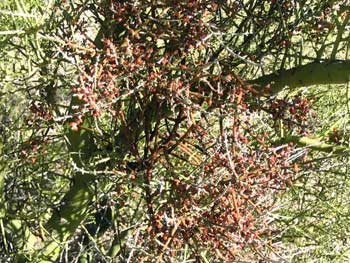BY STEVE JONES | SEPTEMBER 21, 2011
News Flash: Desert mistletoe is not a threat to native trees

Rather, we are the threat
Desert mistletoe (Phoradendron californicum Nutt) is a native plant. It evolved here, and has lived in the Sonoran desert harmoniously for tens of thousands of years. Like white ratany, it is not a true parasite, but a hemiparasite, which means it does its own photosynthesis, and takes only water and a few minerals from its host. Its fruit is an important food source for native birds, and the plant makes a good nesting site and food source for the phainopepla, a native bird known to the native Americans as the “window-wing bird,” because of the male’s prominent white wing patch against a black background. The phainopepla requires this plant in order to survive the winter.
 Mistletoe in Foothill Palo Verde by Dave Mills
Mistletoe in Foothill Palo Verde by Dave Mills
Desert mistletoe grows in bean trees: foothill and blue palo verde, ironwood, mesquite, catclaw acacia. (Stunted specimens of mistletoe can sometimes be found in creosote bushes, which are not in the bean family.) As the old bean trees die, young trees and seedlings grow to take their places, if we leave room for them. Desert mistletoe is not a threat to native trees. We are.
Let me bring up a grossly underrated natural law: the Law of Unintended Consequences. Every one of us violates this law every day. We do it especially when we look at the native desert around us, find it wanting, and then seek to change it. We violate it when we remove particular species. We violate it when we call the exterminator. We violate it when we put out millet and sunflower seeds for the birds, which attracts non-native English sparrows and starlings. We violate it when we put out dog food for the coyotes, and alfalfa for the deer. We violate it when we scrape the life off of land that we are not going to use. We violate it when we trim the bottom branches off our native palo verde trees and other shrub-like trees. We violate it when we spray chemicals to keep the “weeds” down – chemicals kill native seedlings, too.
Most of us came here with an aesthetic honed in other places: the farmlands of the Midwest, the downtowns and suburbs of American cities east of the Rockies, the California coast, or, in my case, Midland, Texas. The Sonoran Desert is truly a strange land to most of us when we meet it. Nowhere else do saguaro cacti grow.
Whether you are a fifth generation Arizona rancher or are newly arrived from suburban Chicago, open your eyes to this wondrous land. Don’t take rake and saw and sprayer to it. Don’t feed the native birds – get out and meet them on their own ground. Watch them with your naked eyes, or with binoculars. Watch what they do, watch how they get their food, watch them bathe in the dust. This is their home as well as ours. They evolved here. Each of them was born here, was nurtured here, will live, and then die here. The same goes for all desert critters, from harvester ant to Gila monster. What we do to “adjust” the desert to our aesthetic affects them directly.
 Mistletoe Berries by Stan Shebs, March 2005, Wikipedia
Mistletoe Berries by Stan Shebs, March 2005, Wikipedia
Many people falsely believe that mistletoe kills its host. It does not. For one good reason: if it kills its host, it dies itself. Dead tree, dead mistletoe. As noted earlier, bean trees and mistletoe have lived in harmony for tens of thousands of years. The system is in overall balance. We disturb the balance when we intervene.
However, if you have a particular tree near your house providing shade, or which is otherwise valuable, no one should begrudge you removing its mistletoe. But do not cut off whole tree branches. Mistletoe is a very fragile plant, and can be broken off by hand, if you don’t mind suffering a few jabs from the host tree’s defenses. The mistletoe may grow back, in which case you simply break it off again.
We can cut out mistletoe, and trim the trees, and feed the birds, coyotes and deer, and throw the system out of balance, or we can strive to have a minimal impact on the native habitat, and try to maintain the balance. Their continued presence depends on us and on our actions. Is that fact worth bearing the occasional offense to our aesthetic ideals?
Originally released by Steve Jones, November 1999; permission granted 2011 to DAC by the author to republish. Steve has a BS in Botany from ASU, and many years of applied Sonoran Desert fieldwork.
SEPTEMBER 21, 2011
Horses Dogs come together to help Vets & their Pets
Horsemen have big hearts, and this year during the 9th Annual Scottsdale Classic, they will have plenty of opportunity to show their support for worthy animal related causes. The nationally renowned quarter horse show returns to WestWorld September 29 - October. In addition to superb competition and exciting events, this year the Classic has expanded its involvement with several charitable organizations to provide them with both publicity and fund raising opportunities.
Over the past few years, The Scottsdale Classic has proved a wonderful venue for matching animals with new, loving homes. Once again, the show is pairing up with local animal organizations to promote rescue, adoption and assistance. These vital services are in a crisis with shelters overflowing and contributions lacking from tough economic times.
Frequently overlooked are the struggles Veterans and their pets endure. Arizona vets are often separated from their pets as they undergo medical treatment or transitional housing. Vets & Their Pets is a non-profit organization that works with the VA and Valley Dog Rescue to assist vets with food, medical care and animal care in times of need. In order to raise awareness as well as much needed funds, the Scottsdale Classic Dog Agility Sweepstakes will be held Thursday evening, September 29, to benefit Vets & Their Pets. Held in the Equidome, the Sweepstakes is sponsored by SmartPak Canine and Contact Zonies agility club. The event is free for spectators. Come and watch these talented dogs fly over jumps, scramble up ramps and dash through obstacles.
Friday September 30, The Scottsdale Classic and “Rein in Cancer” present “Think to Wear Pink” day, encouraging everyone to wear pink while they show. The Rein In Cancer campaign is a horse industry based program that raises money to aid the fight against cancer. Since its inception in 2007, Rein In Cancer has raised tens of thousands of dollars for cancer research and for supporting people with cancer. Rein In Cancer co-founder Cheryl Magoteaux explains, “If you or a member of your family or someone you love has been challenged by cancer, you know how important this fight is. Rein In Cancer exists to honor those who have fought or are still fighting this disease.”
The fun continues Saturday night, October 1, when Three Cowgirls and an Outlaw will host a Silent Auction to raise money for America's Horse Cares. Peggy Kimes and Becky Dunning, coordinators of the event, are masters at procuring interesting home décor, beautiful jewelry, unique gifts and more that will available for bidding. The America's Horse Cares program benefits therapeutic riding programs across the country. The programs foster special relationships between horses and people with special needs allowing them to overcome physical, psychological and emotional barriers, bringing newfound joy, and a sense of achievement. The Auction, paired with the evening’s Rancho Oso Rio Party and the NRHA Futurity Finals will make The Equidome the center of action Saturday night.
All these events are sure to put even more fun into what has become known as the “Fun Show”. The Scottsdale Classic is open to the public, and there is never any entry fee for spectators, so come on out, enjoy some of the best American Quarter Horse competition in the country and support our local charities. You may just find yourself leaving with a new furry companion.
Valley dogs rescue provides needed support services for phoenix-area homeless veterans and their pets.
Often transitional housing will not allow homeless Veterans to bring their pets with them which creates a great need for foster care for the pet while their owner gets back on their feet. These Vets, who care so much for their pets, also need assistance with medical care, food and other pet care.
There are over 300 homeless Veterans with pets in the Phoenix area. Vets and their
Pets was formed by Valley Dogs Rescue to continue to engage the surrounding community through future events to raise funds for this special cause.
www.veteransandtheirpets.org




